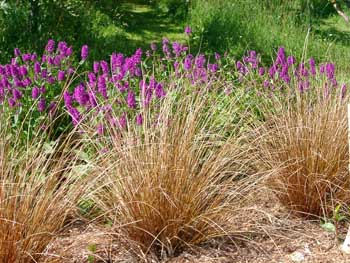Tough plants for tough places: Grasses
Grasses are the ultimate tough plant for the ultimate tough place – Michigan.
Gardeners come in all shapes and sizes. They also have widely differing attitudes about caring for plants. One may coddle a plant for years, moving it from one site to another until it either finally dies or seems happy. Other gardeners live by the “one chance rule.” Plants thrive where they are planted or else!
The art and science of the “one chance rule” has led MSU professor of horticulture Arthur Cameron on a career-long search for plants that duke it out with the worst ecological conditions. Plants from native environments such as the prairie are used to tolerating feast or famine growing conditions, he says. These often become great candidates for your ultimate tough place.
“The ultimate tough place is just about anywhere in Michigan,” says Cameron. Wet or dry, Michigan has all the types of tough environments imaginable. Cameron thinks gardeners just need to learn what to plant and where, he says.
Survivor -- prairie style
|
Early in Cameron’s career, he got involved with researching and planting ornamental grasses. When he started 25 years ago, perennial gardens looked pretty boring by the end of June. With the incorporation of ornamental grasses, he says, regardless of the weather, the season of interest just got longer.
“Now here is the ultimate tough plant,” he grins. “Grasses grow extremely well in dry or wet conditions, don’t need irrigation and even shun fertilizer!”
According to Cameron, ultimate tough plants can handle both ends of the spectrum. Many commercially available ornamental grasses have genetic ties to the prairie which means that these plants have very deep root systems and are tolerant of prolonged moist or dry conditions. The only condition many don’t thrive in is water logged soils. One of Cameron’s favorites is a grass known as Calamagrostis‘Carl Foerster’ or feather reed grass.
“This is the best of the best,” he comments. Once the tiny, frothy lavender flowers appear in June, it dries to a showy blond and holds up throughout the fall and winter. Many of the grasses have exquisite fall color as well as interesting seed heads. Native prairie grasses known as Panicum are both drought tolerant and beautiful. Shenandoah is a popular cultivar but a new Panicum known as Prairie Fire has an even better fall display.
An exuberant garden uses grasses with companion plants
Even though the ornamental grasses that Cameron calls “fall extraverts” are beautiful, when you’re talking an entire landscape comprised of amber waves it seems kind of bland. Cameron started looking for companion plants for his tough grasses and that has been a driving force behind his effort at educating gardeners on the tough plant theory.
|
Plants that fit into this tough plant category may surprise you. Many Heuchera species (coral bells) are known for their minimum moisture requirements. In a defensive mode, perennials often will go dormant through the droughty periods that come on during August and September. While foliage dies back, the roots are just fine. Cameron reminds us that wild ginger is great for dry shade and, believe it or not, Hosta – although thought of as one for moist conditions – can take extended dry periods, too.
When choosing plants for the landscape, he says, “My theory is that the ‘wimps’ should be sited near the watering tap. I think plants should be able to grow on their own, without coddling them.” He believes there is a perennial that will tolerate every tough spot you can imagine.
Astute in world horticulture trends, Cameron says that the Germans have led the way in understanding the ecological needs of a plant. The idea is to match the plant to the environment. This has led many to believe that plants should drive garden design.
Either way, understanding a plant’s needs should be paramount in its location in your garden. If you are a gardener who designs with a plant in one hand and a trowel in the other, you may want to hit the books a bit before you make planting decisions!
You can contact the MSU Master Gardener Lawn and Garden Hotline at 888-678-3464 with your questions.
Related resources on water use or drought:
- Excess drying leads to poor mulch performance, Rebecca Finneran, MSU Extension
- Gardening tips for wise use of your water resources, Mary Wilson, MSU Extension
- Impacts of summer weather on landscape plants, Stephen Fouch, MSU Extension
- Native plants for Michigan landscapes: Part 1 – Trees, Mary Wilson, MSU Extension
- Native plants for Michigan landscapes: Part 2 – Shrubs, Mary Wilson, MSU Extension
- Silence of the soaker hoses, Gretchen Voyle, MSU Extension
Related Source:



 Print
Print Email
Email






